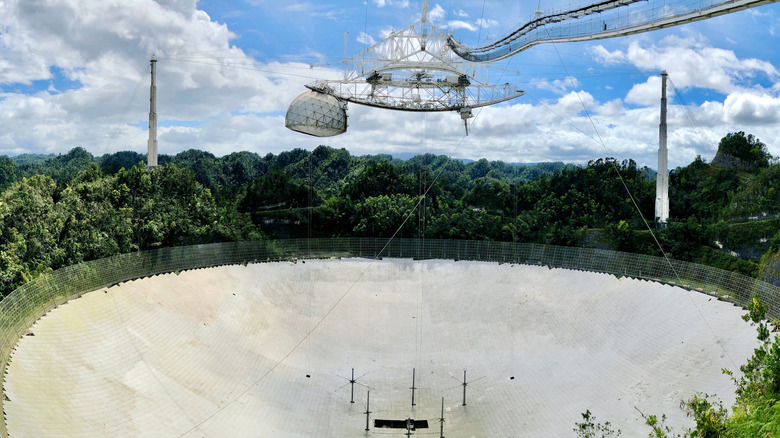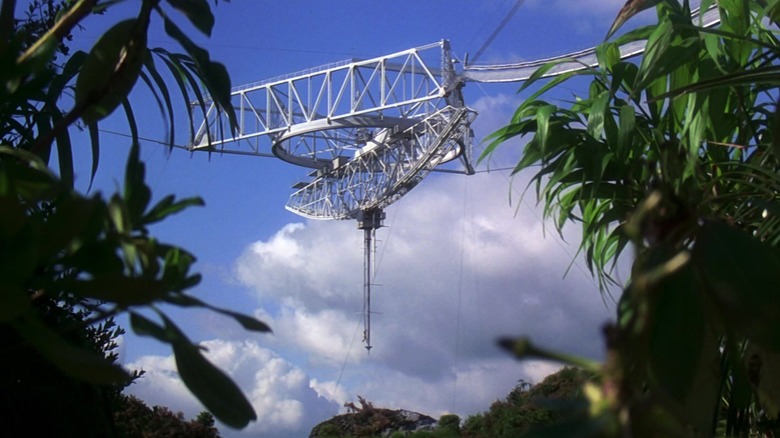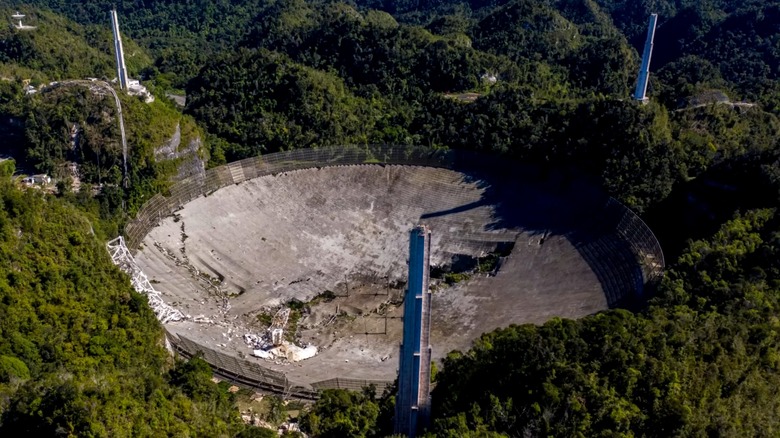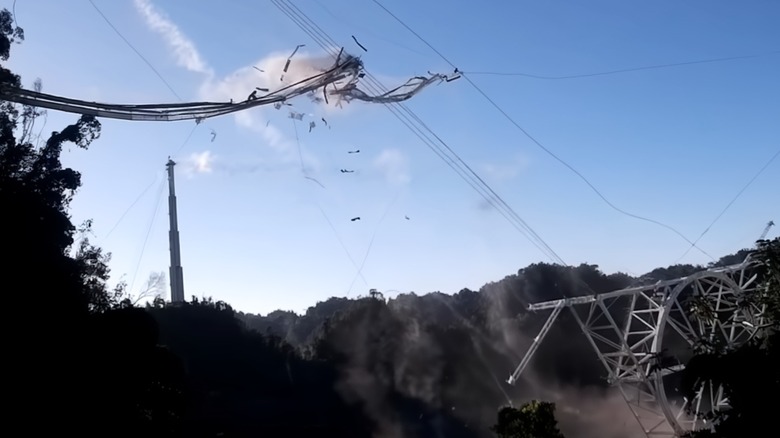The 305-Meter Telescope Made Famous By James Bond That Collapsed In Real Life
There isn't a '90s kid alive that doesn't remember either watching Pierce Brosnan's James Bond fight Sean Bean's Alec Trevelyan on a giant satellite dish in 1997's "GoldenEye," or playing out that fight for themselves in the "GoldenEye 007" video game. In the film, "GoldenEye" refers to a Soviet weapon that includes two satellites armed with nuclear warheads. The secret control center for these satellites houses a massive antenna dish, and is where the climax of the movie takes place. After the giant edifice rises from beneath a lake, Bond faces off against his rival, dangling him from the radio antenna suspended over the dish before letting him fall to his death.
It remains a memorable moment from one of the best Bond movies in the saga's more than 60-year run. Bolstered by the video game and its "Antenna Cradle" final level, the dish makes for one of the more indelible images from 90s-era Bond, but the function of the satellite dish in real life is not to cause financial meltdown in London and thwart England's greatest spy.
The "GoldenEye" satellites' control center is actually the National Science Foundation's giant radio telescope at the Arecibo Observatory in Puerto Rico. Or at least, it was. In 2020, the impressive telescope crumbled after more than 50 years of operation, which considering its crucial involvement in astronomical research and its attachment to Bond history is both a scientific and cultural tragedy. So, what happened to bring this gigantic structure down? And did SPECTRE have anything to do with it?
The GoldenEye device is really a gigantic telescope
Built in 1963 with funding from the Defense Department, the Arecibo Observatory was responsible for numerous astronomical discoveries in its 57 years of operation. Based in Barrio Esperanza, Arecibo, the Observatory was home to a spherical reflector dish some 1,000 feet wide (305 meters), which, along with its 900-ton receiver platform, was the largest radio telescope in the world, until 2016.
Though space telescopes have come to demonstrate numerous advantages over those based on Earth, throughout its existence the giant radio telescope was used for multiple landmark moments in astronomy, from tracking Earth-bound asteroids to helping with research that resulted in a Nobel Prize. The facility was also used in 1974 to send out the most powerful message humans ever beamed into space, with a simple pictorial message being blasted out into the cosmos using the megawatt transmitter attached to the telescope's antenna. Scientists also used the telescope to detect gravitational waves and search for neutral hydrogen, with roughly 250 scientists still using the observatory when it closed in 2020. Graduate students trained at the facility, too, which drew around 90,000 visitors a year when it was active.
Alongside all this, the impressive facility was also home to two LIDAR facilities, which allowed researchers to study the upper atmosphere and ionosphere. For 57 years, the Arecibo Observatory carried out these multiple operations through tropical humidity and multiple earthquakes. Alas, it could not withstand a flaw in its own construction, and came crashing down in December 2020.
The collapse of the Arecibo Observatory telescope
The Arecibo Observatory was an impressive structure that made an even more impressive scene when it collapsed on December 1, 2020. There were no injuries reported at the time, but the facility had been showing signs of deterioration for months before the collapse.
In August 2020, an auxiliary cable snapped, ripping a 100-foot tear into the reflector dish. This cable failure, which also damaged the receiver platform, was followed by the failure of a main steel cable in November of that same year, all but guaranteeing the collapse of the telescope. Those two events led the owners of the structure, the National Science Foundation, to announce the closure of the observatory, citing safety concerns. Scientists worldwide petitioned for the observatory to be kept open, but then disaster truly struck.
On December 1, 2020, the Observatory's 900-ton receiver platform fell 400 feet, crashing into the 1000-foot wide reflector itself in much the same way as Sean Bean's Alec Trevelyan had some 25 years prior. Dr. Jonathan Friedman, who worked at the Observatory, told Puerto Rico's WAPA-TV (via NBC) that the collapse felt like "a train or an avalanche," and that, at first, he thought it was another earthquake.
Why did the Arecibo telescope collapse?
In response to the collapse of the giant telescope, the National Academies of Sciences, Engineering, and Medicine began an investigation, publishing their findings via National Academies Press in October 2024, titled "Failure Analysis of the Arecibo Observatory 305-Meter Telescope Collapse." The report, published in National Academies Press in October 2024, included several concerning revelations, most notably that the steel cables that held up the receiver platform had come loose due to their sockets failing. More specifically, the zinc in those sockets had deformed over time, loosening their grip on the cables and ultimately causing the two cable failures that led to the telescope's destruction.
This process is known as "zinc creep," and this led to the sockets deforming to a load "below half the socket's nominal strength." While this provides an explanation for how the giant telescope's receiver platform collapsed, the explanation itself raises even more pressing questions, with Roger L. McCarthy, chair of the committee who produced the report, asking why there was "excessive zinc creep at such loading" and noting that such a failure "had never been reported previously in over a century of widespread zinc spelter socket successful use."
The report does provide an explanation for this, which takes into account wind speed consideration in the astronomical instrument's design and cable design standards, ultimately putting the blame on low-current electroplasticity, which essentially means the flow of electrical current through the sockets could be the reason why the zinc deformed over time. However, there simply wasn't enough data available to prove that explanation, and a final observation was that the task of fully explaining the collapse of this once magnificent telescope is still ongoing.



